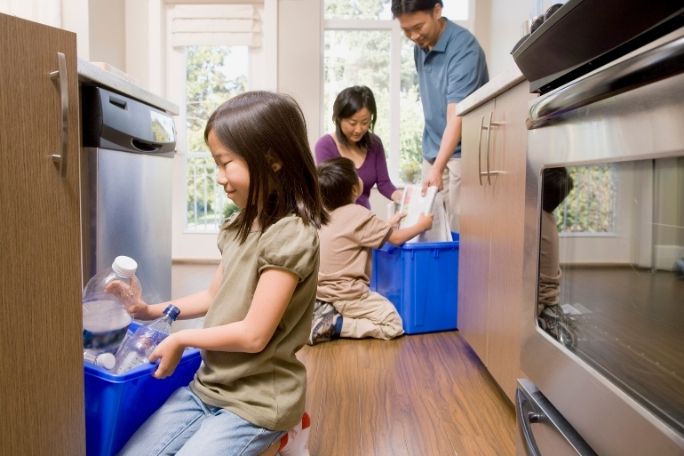Lesson summary
In this lesson, students will build an understanding of the different types of recyclable materials and their impact upon our environment. They will use volume and mathematical skills to calculate school-wide waste projections. Students will approximate the amount of recyclable materials thrown away as rubbish within their school or year level. They will sort materials collected from the playground, lunch boxes or school bags, and fill paper bins or baskets to approximate volume. The shape of the paper bin and relevant volume formulas can be selected to suit different year levels.
Learning intentions:
Students will...
- understand the different types of recyclable materials and its impact upon our environment
- be able to use volume and mathematical skills to calculate school-wide waste projections
Success criteria:
Students can...
- sort collected recyclables into the different recyclable groups
- use real dimensions of a paper bin to apply volume formulas
- use assumptions and calculations to make projections about recyclable material entering landfill
Lesson guides and printables
Lesson details
Curriculum mapping
Australian curriculum content descriptions:
Year 7 Maths: Use rectangular paper bins (ignoring slopes, assuming bin is a prism) –
- Calculate volumes of rectangular prisms (ACMMG160).
Year 8 Maths: Use rectangular paper bins and consider slopes (assuming bins are trapezoids) –
- Develop formulas for volumes of rectangular and triangular prisms and prisms in general (ACMMG198).
- Use formulas to solve problems involving volume (ACMMG198).
Year 9 Maths: Use cylindrical bins (ignoring slope, assuming bin is a prism) –
- Calculate the surface area and volume of cylinders and solve related problems (ACMMG217).
Year 10 Maths: Use cylindrical bins and consider slope or obscurely shaped bin –
- Solve problems involving surface area and volume for a range of prisms, cylinders and composite solids (ACMMG242).
Syllabus outcomes: MA3-11MG, MA3‑1WM, MA3‑2WM, MA3‑3WM.
General capabilities: Numeracy, Critical and creative thinking, Ethical understanding.
Cross-curriculum priority: Sustainability OI.8.
Relevant parts of Year 7 Mathematics achievement standards: Students use formulas for the area and perimeter of rectangles and calculate volumes of rectangular prisms.
Relevant parts of Year 8 Mathematics achievement standards: Students solve problems relating to the volume of prisms.
Relevant parts of Year 9 Mathematics achievement standards: Students calculate areas of shapes and the volume and surface area of right prisms and cylinders.
Relevant parts of Year 10 Mathematics achievement standards: Students solve surface area and volume problems relating to composite solids.
Unit of work: Visy Education – Secondary Mathematics.
Time required: 90 mins.
Level of teacher scaffolding: Medium – Teacher may need to assist students with making assumptions regarding the dimensions of the paper basket, particularly when slope is considered.
Resources required
- Student Worksheets (one per student)
- Recycling Quiz
- Recycling Reference
- Device capable of presenting a video to the class and projecting images/charts
- Paper bin/s of appropriate shape (e.g. rectangular for Years 7 and 8, cylindrical for Years 9 and 10)
- Latex-free gloves for students to collect and sort rubbish
- Litter sticks or kitchen tongs (at least one between two)
- Plastic sheet, newspapers or a large rubbish bag to place on the ground
- Rulers to measure the dimensions of the paper bin
- Calculators
Skills
This lesson is designed to build students’ competencies in the following skills:
- Critical thinking
- Global citizenship
- Problem solving
- Social skills
Additional info
This lesson has been developed in partnership with Visy. For over 70 years Visy has been committed to finding sustainable solutions for Australia and New Zealand’s recyclables and helping to reduce local landfills. Visy collects, receives and sorts paper, cardboard, glass, plastics, steel and aluminium from households, businesses and schools with the purpose of reusing these products in the re-manufacture of new packaging products.


Welcome back!
Don't have an account yet?
Log in with:
By signing up to Cool.org you consent and agree to Cool's privacy policy to
store, manage and process your personal information. To read more, please see
our privacy policy here(Opens in new tab).
Create your free Cool.org account.
Many of our resources are free, with an option to upgrade to Cool+ for premium content.
Already have an account?
Sign up with:
By signing up to Cool.org you consent and agree to Cool's privacy policy to
store, manage and process your personal information. To read more, please see
our privacy policy here(Opens in new tab).